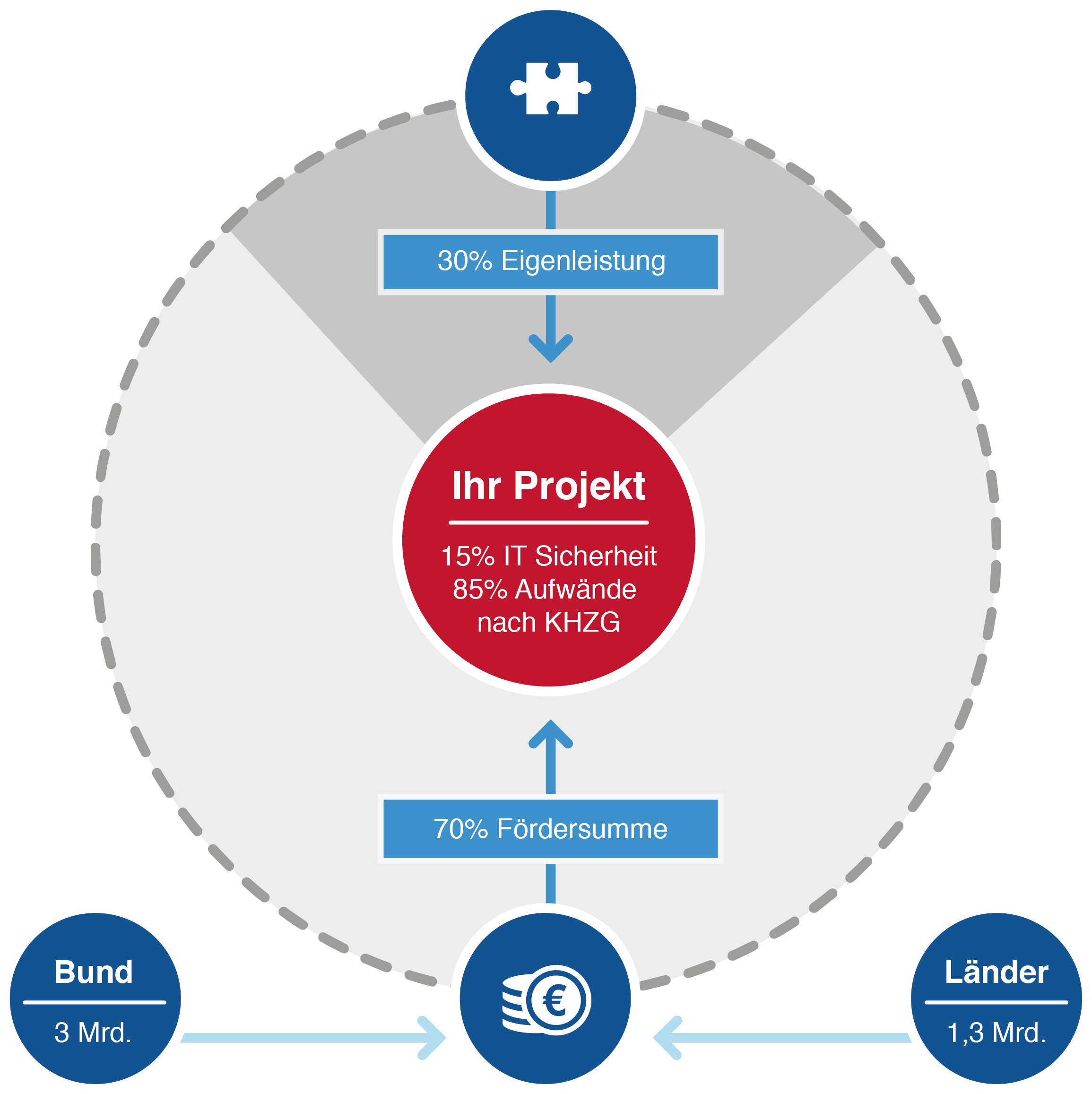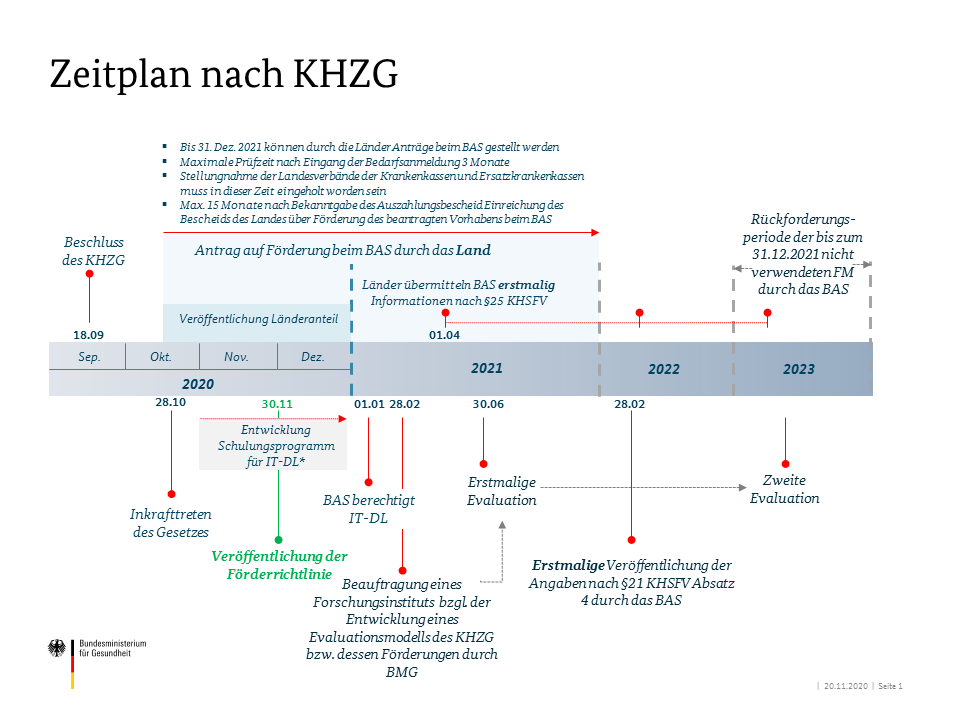The law in brief
4.3 billion euros by federal and state governments
70 % Promotion of a project
11 Eligibility
15 % Investment in IT security
Payment since 21.01.2021
Evaluation as of 30.06.2021 and 30.06.2023 respectively
The INIT in a nutshell
Our team is trained by BAS according to § 21 paragraph 5 sentence KHSFV.
We are authorized to develop and implement projects under the KHSF.
We advise and guide you professionally through the complete application process.
We advise in partnership and at eye level.
Frequently asked questions about the funding guideline
What is the funding amount?

How are the grant funds to be used?
15% of the funding volume must be used for IT security. Eligible costs are:
- The following costs may be reimbursed for the projects referred to in Section 19(1):
- the costs of necessary technical and information technology measures, including the costs of consulting services for planning the specific project,
- the costs for necessary personnel measures including the costs for training of employees,
- the costs of spatial measures, insofar as they are necessary for the technical, information technology and personnel measures; however, in the case of the projects specified in section 19(1), first sentence, numbers 1 to 10, the costs of spatial measures may account for no more than 10 percent of the funding granted, and
- the costs of obtaining evidence pursuant to Section 25(1)(2).
- In the case of the projects referred to in Section 19 (1) sentence 1 number 7, if technical and information technology measures are required, reimbursement may be made in particular for the costs of providing the system and for connecting the hospital or other service providers to the system, including the software required for its use. n the case of the projects referred to in Section 19 (1), first sentence, numbers 9 and 10, in the case of necessary technical and information technology measures, reimbursement shall be made in particular for the hospital’s costs for the procurement, construction, expansion or development of information or communication technology systems. The costs of construction under sentence 2 also include the hospitals’ direct costs of providing a secure connection to the outpatient facility.
- § Section 2 (3) sentences 2 and 3 and (4) shall apply mutatis mutandis.
What is the time horizon?

What can be funded?
Modernization emergency room
Adaptation of the technical / information technology equipment of a hospital’s emergency department to the current state of the art.
Patient portals
In the future, patient portals should reduce the communication effort, accelerate the exchange of information and improve the quality of care for patients.
Care and treatment documentation
Two main topics will be considered for this funding category: digital care and treatment documentation and systems for automated and voice-based documentation.
Clinical decision support systems
This includes the support of decision-makers in the choice of diagnostics, therapy or medication. New scientific findings should be made available as quickly as possible in the provision of care.
Digital medication management
End-to-end digital documentation of medication in interoperable systems and the constant availability of this information is required for all those involved in the treatment process.
Digital request for therapy
Consistent digital request and/or automated request for diagnostic or treatment plans and simultaneous digital feedback for findings make communication faster and reduce errors in treatment.
Reconciliation of the power requirements
By means of cross-site care structures, hospitals are to coordinate their range of services with one another in such a way that comprehensive, needs-based and, as far as possible, specialized inpatient care can be guaranteed.
Online based bed verification
These systems are particularly important in prehospital care – especially for cooperation between hospitals and rescue services, control centers and other players.
Telemedicine network structures
Procurement, construction, expansion, or development of information technology, communications technology, and robotics-based equipment, systems, or processes and telemedicine networks.
Improvement of IT security
As a result of increasing digitization and the associated processes, IT or cyber security should also be improved in hospitals that do not belong to the critical infrastructures according to the BSI Act (BSI Criticality Ordinance) as well as in university hospitals.
Adapt patient rooms to epidemic situation
Adaptation of patient rooms to the special forms of treatment in the event of an epidemic
What are the requirements of a grant application?
General requirements
Additional requirements for hospitals or university clinics
How does the application process work?
1. determination of the status quo
The status quo of digitization and the requirements are determined in a target/actual analysis.
The result of this preliminary project is a list of all possible individual projects
2. elaboration of individual projects and submission of applications
Individual projects are analyzed for eligibility (e.g.: must/can requirements, cost structure) and requirements applications are completed in conjunction with the certified IT service provider.
3. application delivery
The hospital owner formally submits the certificate of need to the appropriate state.
4. decision on promotion
The state advises on which projects should apply for funding from the Federal Social Security Office and submits them to the Federal Social Security Office.
5. allocation of fundsl
Finally, the BAS reviews the applications submitted and allocates funds from the Hospital Future Fund.
6. verification of sustainability
The status of digitization will be measured as of June 30, 2021, and June 30, 2023, respectively. If a hospital does not have all of the digital services requested and approved when measured on June 30, 2023, there will be a 2% reduction in the amount billed for each case beginning in 2025.

How is the degree of digitization determined?
The German Federal Ministry of Health (BMG) will commission a review by February 2021 to show the extent to which the funding has led directly or indirectly to an improvement in the digital maturity of hospitals.
For this purpose, the status of digitization at hospitals will be evaluated as of June 30, 2021, and June 30, 2023, respectively. From 2025, a discount of up to 2% of the invoice amount will be applied for each full and partial inpatient case if a hospital does not provide all of the digital services listed in the Hospital Structure Fund Ordinance.
At the time of going to press (early April 2021), it was not yet clear exactly how the level of digitization would be determined.
The next step:
Feel free to contact us at any time if you have further questions about the KHZG or would like to request more information without obligation. We are happy to advise you
